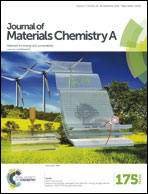Highly efficient electro-reduction of CO2 to formic acid by nano-copper†
Abstract
Ultra-fine copper(II) oxide nanoparticles were used for the electrocatalytic reduction of CO2 to formic acid at high Faradaic efficiencies. The nanoparticles were directly synthesised via continuous hydrothermal flow synthesis (CHFS) process, which used water as a solvent and reagent. The as-prepared nanoparticles were subsequently formulated into Nafion based inks. For the electroreduction of CO2, the influence of Nafion fraction on the Faradaic efficiencies and overpotential (for formic acid production), was explored over a wide potential range. The highest Faradaic efficiency for formic acid production (61%) was observed with a 25 wt% Nafion fraction, at a potential of −1.4 V vs. Ag/AgCl. Some insights into the significant increase in Faradaic efficiency for the production of formic acid with the optimum Nafion content, was elucidated with electrochemical impedance spectroscopy.


 Please wait while we load your content...
Please wait while we load your content...